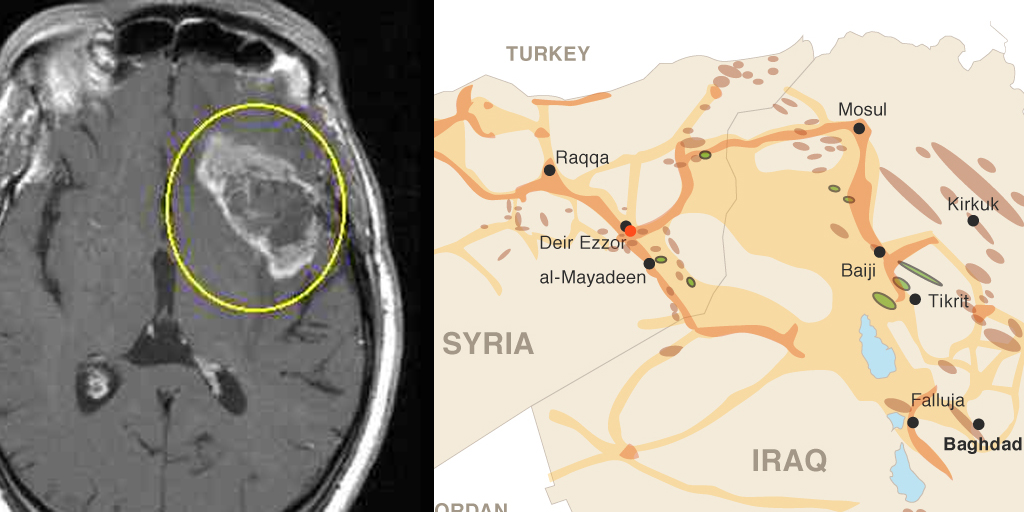Maps of territory held by the Islamic State, or ISIS, bugged me, but I couldn’t put my finger on it. Then, I realized, they look like scans of brain tumors.

Unfortunately, the similarities go much deeper.
Glioblastoma multiforme (GBM), the most aggressive type of brain tumor in adults, is characterized by its ability to turn a broad mix of cell types into cancer cells. Foreign fighters from about four dozen nations have joined ISIS in Syria and Iraq.
Both produce seizures.
GBM tumors feed off a large network of blood vessels. ISIS fuels its growth through a large network of captured oil fields and looted bank treasuries.
As it spreads, a GBM tumor leaves a distinctive area of dead tissue at its center. As ISIS spreads, it erases artistic, cultural and historical heritage.
GBM tumors are nearly always fatal, killing most patients within two years. ISIS kills even faster, and wantonly.
Given these parallels, could we adapt lessons from cancer medicine to fight ISIS?
Doctors attack GBM tumors with a variety of methods, because some work well in certain cells but not in others. Most often they combine surgery, chemotherapy and radiation. Here, our analogy breaks down. Chemical warfare is banned, and radiation is unusable except in retaliation, should nuclear deterrence fail. Both weapons create too much collateral damage—losses we accept in healthy brain cells but not for human noncombatants.
Surgery, and conventional warfare, have become increasingly precise. But surgery usually fails to cure GBM because of its “topographically diffuse nature,” writes neurosurgeon Eric C. Holland. The tumor sends tendrils of malignant cells into surrounding tissue, leaving no clear margin for the scalpel. ISIS maps show its tendrils leading in all directions.
Precision airstrikes have slowed the ISIS advance. Some politicians are calling for “boots on the ground” (A larger scalpel, please!), and more may be needed. Hopefully, most will be on the feet of soldiers from neighboring countries. Any large scale U.S. invasion of Iraq or Syria would probably be about as useful as trying to treat a brain tumor will a hammer.
Medical researchers are using immunotherapy to fight GBM tumors. They draw white blood cells from the patient and sensitize them with protein antigens from the tumor. Injected back into the patient, these antibodies attack only the cancerous cells.
Combination therapy seems to describe the U.S. strategy. We’re bombing visible targets, supporting neighboring troops, and trying to dry up ISIS finances. Working with mainstream Muslim leaders to encourage contempt rather than sympathy for ISIS seems a bit like immunotherapy. By burning other Muslims alive, ISIS is probably doing more in this regard than any opponent could achieve.
It is unknown whether these methods will defeat ISIS, but one fact about brain tumors is inescapable—they all die once they kill their host.



